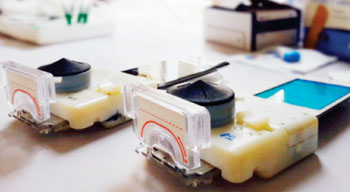A First – Smartphone Diagnostic Device Replicates Quality of Lab Blood Test
By LabMedica International staff writers
Posted on 10 Feb 2015
Researchers have developed a hand-held smartphone accessory that can perform a low-cost, point-of-care (POC), lab-quality test that simultaneously detects 3 infectious disease markers from a single finger-prick blood sample in only 15 minutes. The device can also be further developed to test for additional biomarkers.Posted on 10 Feb 2015
In a multi-institutional collaboration, the team of researchers, led by Samuel K. Sia, associate professor of biomedical engineering at Columbia Engineering (New York, NY, USA), developed and field-tested the miniature device that, for the first time, replicates all mechanical, optical, and electronic functions of a lab-based blood test. Specifically, it performs an enzyme-linked immunosorbent assay (ELISA), without requiring stored energy as all necessary power is drawn from the smartphone. It also performs a triplexed immunoassay not currently available in a single test format: HIV antibody, treponemal-specific antibody for syphilis, and non-treponemal antibody for active syphilis infection.

Image: Newly developed diagnostic smartphone accessory device successfully performed point-of-care HIV and syphilis tests in Rwanda from finger-prick whole blood in 15 minutes, operated by healthcare workers easily trained via a software app (Photo courtesy of Samiksha Nayak for Columbia Engineering).
Prof. Sia’s innovative accessory (or dongle) was recently piloted by healthcare workers in Rwanda, who trained via a software app then tested 96 patients from prevention-of-mother-to-child-transmission clinics or voluntary counseling and testing centers.
“Our work shows that a full laboratory-quality immunoassay can be run on a smartphone accessory,” said Prof. Sia, “Coupling microfluidics with recent advances in consumer electronics can make certain lab-based diagnostics accessible to almost any population with access to smartphones. This kind of capability can transform how health care services are delivered around the world.”
Prof. Sia’s team built upon their previous work in miniaturizing diagnostics hardware for rapid POC diagnosis of HIV, syphilis, and other sexually transmitted diseases. “We know that early diagnosis and treatment in pregnant mothers can greatly reduce adverse consequences to both mothers and their babies,” Sia notes. The team developed the dongle to be small and light enough to fit into one hand, and to run assays on disposable plastic cassettes with pre-loaded reagents, where disease-specific zones provide an objective read-out, much like an ELISA assay.
Prof. Sia estimates the dongle will have a manufacturing cost of USD 34, much lower than the USD 18,450 that typical ELISA equipment runs.
The team made two main innovations to achieve low power consumption, a must in places without dependable electricity. They eliminated the power-consuming electrical pump by using a “one-push vacuum,” where a user mechanically activates a negative-pressure chamber to move a sequence of reagents pre-stored on a cassette. The process is durable, requires little user training, and needs no maintenance or additional manufacturing. The team was able to implement a second innovation to remove the need for a battery by using the audio jack for transmitting power as well as for data transmission. And, because audio jacks are standardized among smartphones, the dongle can be attached to any compatible device (including iPhones and Android phones) in a simple plug-and-play manner.
During the field testing in Rwanda, healthcare workers were given 30 minutes of training, which included a user-friendly interface, step-by-step pictorial directions, built-in timers to alert to next steps, and records of test results for later review.
The work, by Laksanasopin T, Guo TW, et al., was published February 4, 2015, in the journal Science Translational Medicine.
Related Links:
Columbia Engineering









 assay.jpg)




